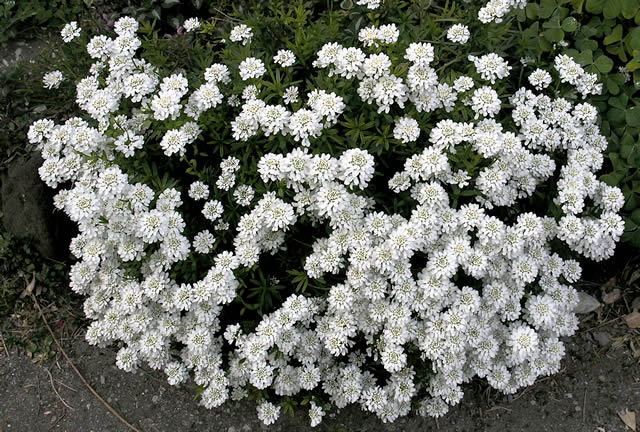
Perennials, Woody > Iberis > Iberis sempervirens > Iberis sempervirens
Iberis sempervirens
Candytuft
Origin: Found in Southern Europe in 1731.
Mike's
Opinion


"
Although considered by many to be perennial I have included it here under evergreen shrubs because it can have a strong presence in the garden through the winter months.
Michael Pascoe, NDP., ODH., CLT., MSc. (Plant Conservation)
"
| Family |
| Brassicaceae |
| Genus |
| Iberis |
| Species |
| sempervirens |
| Category |
| Perennials, Woody |
| Type |
| Shrub (evergreen) |
| Pronunciation |
| USDA Hardiness Zone |
| 4-8 |
| RHS Hardiness Zone |
| H7 |
| Temperature (°C) |
| -35 -20 |
| Temperature (°F) |
| -31 - 67 |
| Height |
| 15-30 cm |
| Spread |
| 15-45 cm |
Photographs
Description and Growing Information
Flowering Period
| General Description |
| Short evergreen, white flowers slightly pink at times, dark green foliage. Trimmed plant is much more compact. |
| Landscape |
| This plant is typically used as a groundcover. Excellent for use as edging. Forming a dense mat of foliage and white spring blooms. It can be sheared to promote a dense compact habit! |
| Cultivation |
| Grows in full sun and well drained soils, can withstand defoliation and cold temperatures. |
| Shape |
| Small spreading evergreen perennial, with a compact dense form; mound shaped growth. |
| Growth |
| Medium |
| ID Characteristic |
| Small spreading evergreen, white flowers, groundcover, likes well-drained soils and full sun. |
| Pests |
| Club root, damping off, powdery mildew and white rust. |
| Habitat |
| Native to Southern Europe and Western Asia. |
| Bark/Stem Description |
| Dark green and fleshy when young, turning semi-woody and brown with age; many branched. |
| Flower/Leaf Bud Description |
| Slender, obuvate, 6-12 mm. |
| Leaf Description |
| Glossy dark green, linear shaped, alternate pattern, in harsher winter climates leaves may have a lighter colour. |
| Flower Description |
| Small perfect white flowers with four petals, not very showy. 2.5-3.75 cm umbels, when in bloom, they engulf the plant giving it the look of snow. |
| Fruit Description |
| Fruits are small and slender, unattractive, usually sheared off to promote compactness in the plant. |
| Colour Description |
| Dark green foliage that has a waxy coating. Flowers are pure white in bloom, sometimes turning pink with age. |
| Texture Description |
| Herbaceous waxy green stem turning woody-brown with age. |
| Notable Specimens |
| The A.M. Cuddy Gardens, Strathroy, Ontario, Canada. The Royal Botanical Gardens, Burlington, Ontario, Canada. |
| Propagation |
| Most common propagation method is by seed. Fleshy cuttings can also be used. |

.jpg)